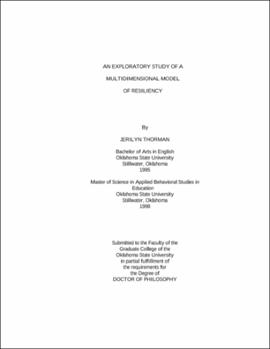| dc.contributor.advisor | Montgomery, Diane | |
| dc.contributor.author | Thorman, Jerilyn | |
| dc.date.accessioned | 2013-11-26T08:34:56Z | |
| dc.date.available | 2013-11-26T08:34:56Z | |
| dc.date.issued | 2007-12 | |
| dc.identifier.uri | https://hdl.handle.net/11244/7596 | |
| dc.description.abstract | Scope and Method of Study: The purpose of this study was to establish a basis in the philosophy of the third wave of resiliency, conceptualized by Richardson (2002), as a motivational force which drives an individual to experience personal growth through hardship. Two theoretical constructs were created to examine the relationship between the motivational force and positive adaptation within the context of adversity. One hundred and sixty-seven third, fourth, and fifth grade students considered "at risk" participated in this study by completing measures of the variables associated with each construct. The first construct, Resilient Force, represented the motivational force and was operationalized by measures of sense of purpose, sense of belonging, hope, and creativity. The second construct, Emotionality, represented positive adaptation and was operationalized by measures of anger, anxiety, depression, and disruptive behavior. Bivariate correlational analyses were employed to assess the convergence of the variables within each construct. Canonical correlational analysis was utilized to assess the multivariate relationship between the Resilient Force Emotionality constructs. | |
| dc.description.abstract | Findings and Conclusions: With the exception of creativity all of the variables within the Resilient Force construct were positively correlated to a moderate degree. Correlations between creativity and sense of purpose and creativity and hope were not statistically significant. Creativity and sense of connectedness shared a low negative correlation. The variables within the Emotionality construct demonstrated were all positively intercorrelated. The results of the canonical correlational analysis between the Resilient Force and Emotionality variable sets indicated that the two constructs shared a considerable proportion of the variance, about 46 %. Several conclusions can be inferred from the results of the analyses. Although creativity defined as divergent production did not seem to fit within the Resilient Force construct, the convergence of sense of purpose, sense of connectedness, and hope provided empirical evidence that the theoretical construct of Resilient Force exists in actuality. Likewise, the Emotionality construct was observable among the children who participated in this study. Furthermore, the findings indicate that there is a strong relationship between an individual's Resilient Force and his or her adaptation. Implications for theory, research and practice are discussed within the paper. | |
| dc.format | application/pdf | |
| dc.language | en_US | |
| dc.rights | Copyright is held by the author who has granted the Oklahoma State University Library the non-exclusive right to share this material in its institutional repository. Contact Digital Library Services at lib-dls@okstate.edu or 405-744-9161 for the permission policy on the use, reproduction or distribution of this material. | |
| dc.title | Exploratory study of a multidimensional model of resiliency | |
| dc.contributor.committeeMember | Bull, Kay | |
| dc.contributor.committeeMember | Carlozzi, Barbara | |
| dc.contributor.committeeMember | Miller, Janice | |
| osu.filename | Thorman_okstate_0664D_2609.pdf | |
| osu.accesstype | Open Access | |
| dc.type.genre | Dissertation | |
| dc.type.material | Text | |
| dc.subject.keywords | resiliency | |
| dc.subject.keywords | children | |
| dc.subject.keywords | emotional states | |
| dc.subject.keywords | education | |
| thesis.degree.discipline | Educational Psychology | |
| thesis.degree.grantor | Oklahoma State University | |
